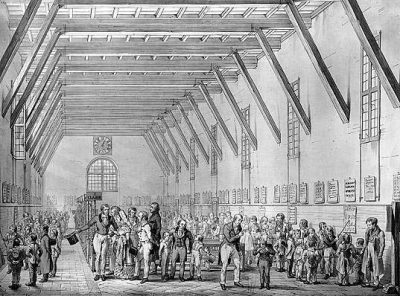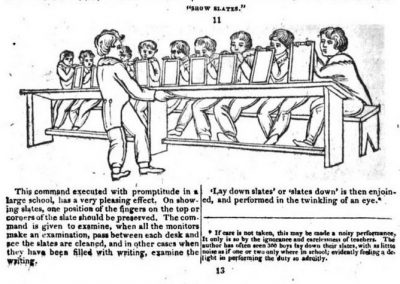On Patricia Crain’s “Children of Media, Children as Media”

Media do more than relay messages — they can wield power over perceptions, relationships, and people. Patricia Crain’s essay “Children of Media, Children as Media” illustrates this point. Crain shows how the idea of the optical telegraph, a media innovation of the French Revolution, influenced new theories of childhood education that spread far beyond use of the telegraph itself. At American Indian mission schools in the nineteenth century, the metaphor of the optical telegraph promised to discipline Indian children into messengers of white “civilization,” becoming an instrument of colonial power.
A distant precursor to the electric telegraph, optical telegraphs rose like mutant windmills across the countryside of Revolutionary France in the 1790s. Each optical telegraph featured large mechanical shutters that moved into various positions to display semaphore code. French semaphore lines located a telegraph tower every ten kilometers (6 miles), allowing operators with telescopes to receive and then replicate short messages down the line faster than a rider on horseback. By the early 1800s, semaphore lines linked Paris to most major French cities, speeding long distance communication and linking the nation under centralized military command. Optical telegraphs saw more limited use outside France, but Patricia Crain argues that the idea of the visual telegraph in public discourse had wider influence than its actual implementation.
For Joseph Lancaster, an English educational reformer, the metaphor of the visual telegraph held the key to making public education more efficient and widespread. Rather than small classes of students working closely with a teacher, Lancaster proposed the “Monitorial System,” which allowed a single schoolmaster to supervise hundreds of students by appointing advanced pupils as “monitors” to replicate lessons for smaller study groups. Lancaster recommended spacing these groups throughout a large hall around instructional posters that replaced textbooks and allowed many students to share simultaneously in a lesson. A simplified visual “telegraph” made of cards bearing short commands such as “SS” for “Show Slates” allowed the schoolmaster to quickly send instructions throughout the class. Obedience was rewarded with prizes, while those who disobeyed faced public shaming by wearing labels that telegraphed their misdeeds to their peers.

Lancaster’s Monitorial System cut down on the cost of teachers and books while promising to diffuse knowledge from cultural elites to the masses. These characteristics, combined with Lancaster’s active promotion, made the system attractive to many nineteenth century protestant missionaries who ran schools for American Indians. Insisting that Indians must either adopt white “civilization” or face extinction, the American Board of Commissioners for Foreign Missions embraced Lancaster’s methods of rapid telegraphic instruction at places such as Brainerd School in Tennessee that sought to teach large numbers of Indian children using limited resources.
In Crain’s analysis, Lancaster’s classroom telegraph “literally incorporates the student into a network; only when the student performs the cued action can the network proceed.” As such, “The Lancasterian student is not so much a surface to be written on as he is a surface upon which messages can be posted.” The scale and speed of instruction left little room for private interior thought, instead; the system demanded outward mimicry to participate in the orderly social body of the classroom. Students, especially monitors, became media themselves as they replicated and retransmitted their teacher’s example (pp. 66-70).

At Indian missions, social replication went beyond simply drilling students in the rudiments of a foreign culture. Missionaries at Brainerd School gave Cherokee children English names such as Samuel Worcester, Lyman Beecher, and Jeremiah Evarts that memorialized other missionaries and evangelical figures. When these students were called on to write letters to benefactors showing their educational progress, Crain argues, they became “vehicles of white memory” and “publicity agents for the missionary project” (p 81). Like the student monitors in Lancaster’s classrooms, these children became media in their own right as they replicated and relayed the values of the colonizing culture for white consumption.
Crain built her interpretation from the perspectives of educators and white writers, and her essay unfortunately skirts around the content of the letters written by Cherokee children themselves. As Crain briefly acknowledges, “these letters convey their writers’ unique voices, as well as expressions of political will” in ways that sometimes “seem far removed from Lancaster’s original system.” (p. 81) It would be helpful to know more about how students described their educational experience. It would also be worthwhile to consider how the role of student monitor might have afforded some Cherokee children limited agency in the educational process. These issues suggest that while Indian schools clearly worked as instruments of colonialism and cultural suppression, new education media may also have provided Indians with novel opportunities to speak back to colonial power.
Despite a few missed opportunities, Crain’s analysis of the optical telegraph and the monitorial system clearly illustrates the power of new media devices and the discourses that surround them. While the optical telegraph itself had only limited implementation, it offered a conceptual model of rapid, centralized communication that imposed new relationships between capital and periphery, teacher and student, colonizer and colonized. As we consider the new media of the twenty first century, we would do well to keep such issues of power in mind.
Reviewed Work: Crain, Patricia. “Children of Media, Children as Media: Optical Telegraphs, Indian Pupils, and Joseph Lancaster’s System for Cultural Replication.” In New Media, 1740-1915, edited by Lisa Gitelman and Geoffrey B. Pingree. Cambridge, Mass: MIT Press, 2003. 61-90.
One Response to "On Patricia Crain’s “Children of Media, Children as Media”":
Thanks for this! And you’re right that I don’t say enough about the Cherokee students. Following the lead of scholars like Hilary Wyss, who has also written about these students, I do say more in a revised version of this essay, in a chapter of my book Reading Children (U Penn P, 2016), which is also available online (in academic libraries, anyway) via De Gruyter.
Comments are closed.